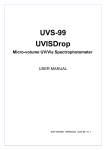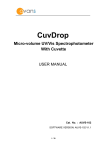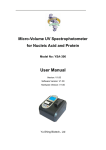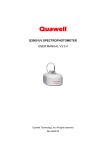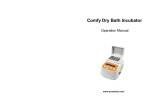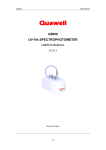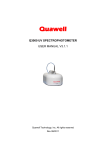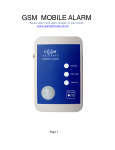Download Avans NAS-99 User Manual-EN
Transcript
NAS-99 NuDrop Micro-volume Nucleic Acid spectrophotometer USER MANUAL SOFTWARE VERSION:V1.0 Contents 1. OVERVIEW .............................................................................................. 1 1.1 Introduction .......................................................................................... 1 1.2 Operation ............................................................................................. 1 1.3 Applications ......................................................................................... 2 2. Installation................................................................................................ 3 2.1 Computer requirements ....................................................................... 3 2.2 Software Installation ............................................................................ 3 3. General Operation ................................................................................... 6 3.1 Sample size ......................................................................................... 6 3.2 Measurement Processes ..................................................................... 6 Nucleic Acids ....................................................................................... 8 Protein A280 ........................................................................................ 9 3.3 Hardware diagnosis ........................................................................... 10 3.4 Factors of affecting the measurement results .................................... 11 4. Quality Evaluation ................................................................................. 12 4.1 CV (DNA) ........................................................................................... 12 4.2 DNA Solution Curve ........................................................................... 12 5. Troubleshooting .................................................................................... 13 5.1 Unable to find USB device ................................................................. 13 5.2 Optics System Checking .................................................................... 14 5.3 Sample accuracy and reproducibility ................................................. 14 6. Set up of the Calibration Parameters ................................................... 16 Definition: .............................................................................................. 16 7. Maintenance and Warranty ..................................................................... 19 7.1 Cleaning ............................................................................................ 19 7.2 Parts that require replacements ......................................................... 19 8. Appendix ................................................................................................ 22 8.1 Instrument specifications ................................................................... 22 8.2 Absorbance calculation ...................................................................... 22 8.3 Concentration Calculation (Beer-Lambert Law) ............................... 233 1. OVERVIEW 1.1 Introduction NAS-99 is a nucleic acid spectrophotometer that measures 1.5~ 2.5 μl samples with high accuracy and reproducibility. It utilizes a sample retention technology that employs surface tension alone to hold the sample in place. No cuvettes or capillaries or other positioning instruments is required. It’s simple to operate and easy to clean by swiping with a laboratory wipe. Furthermore, NAS-99 can measure high concentration samples without dilution (50× higher concentration than a general spectrophotometer can measure). 1.2 Operation Simply pipette 1.5~ 2.5μl sample onto the measurement pedestal, and then lay down the sampling arm to contact with the liquid sample. The liquid sample will bridge the gap between both optical fibers. The gap is controlled to both 1mm and 0.2mm paths. NAS-99 can automatically complete the whole measurement process within 3 seconds. The UV-LED provides the light source and a spectrometer utilizing a photoelectric cell is used to analyze the light after passing through the sample. The instrument is controlled by the software installed in a computer. Open Drip -1- Measure 1.3 Applications NAS-99 is a special spectrophotometer for nucleic acid measurement. The light source is UV-LED. The deep ultraviolet ray is the main light source, adopting 260nm and 280nm. The shallow ultraviolet ray is the reference wavelength, adopting 380nm. It can accurately measure nucleic acid samples and eliminate the influence by any kind of impurity. Please pay attention that the interval time between each measurement had better be more than 10~15 seconds. -2- 2. Installation 2.1 COMPUTER REQUIREMENTS ● Operation system: Windows7 & above ●Office Excel 2007, 2010 & above ● USB port ● Screen 2.2 Software Installation The NAS-99 software must be installed onto the computer before the USB cable is connected. The NAS-99 software is in the CD-rom provided. Please pay attention here. Please use “Administrator” ID to log in the Microsoft operation system. The installation procedures are detailed as follow: ● Insert the CD-rom into the CDROM unit. the CD-rom provided to the computer. Copy and save the software on Double click the “setup” program and click “OK” to continue the installation. -3- ● Change directory. Please pay attention here. Because of the security control of Microsoft operation system, please install the software to non-system drive, that is, D Drive or E Drive. ● After installation, connect NAS-99 unit with the computer by the USB cable provided and then “Found New Hardware Wizard” should pop up on the computer screen as shown below.. ● Select “Install the software automatically (Recommended)”. Click “Next” and the installation will be completed automatically. -4- ● Your NAS-99 should be ready for operation. -5- 3. General Operation 3.1 Sample size The volume of sample is not limited, though, the liquid sample must be formed and bridged between the optical fibers. 1.5~ 2.5μl is the best volume. 3.2 Measurement Processes Check the connection between NAS-99 and the computer. power on/off switch. software. ● Turn on the Make sure the sampling arm is closed and then run the NAS-99 will perform self-check procedure. Blanking · Each time a software module is opened (initiated), the “Measure” button is inactive. A blank must first be measured before the “Measure” button becomes active. · Lift the sampling arm, then pipette 1.5~ 2.5μl of the blank sample (the buffer, solvent, or carrier liquid used with your samples) onto the measurement pedestal. · Lay down the sampling arm and make sure the solution bridges the gap between both optical fibers. · Click the button “Blank”. NAS-99 will measure the solution with both 1mm and 0.2mm path lengths, and then the system will record both results automatically. No need to re-blank unless samples are in different solutions. · When the measurement is complete, open the sampling arm and wipe the blanking buffer from both pedestals using a laboratory wipe. ● Sample measurement · Type the “Sample ID” and select the “Sample Type”. · For Nucleic Acid Samples : Pipette 1.5~ 2.5μl sample onto the measurement pedestal while the sampling arm is opened. -6- · For Protein Samples : It is suggested to pipette 2~4μl sample onto the measurement pedestal while the sampling arm is opened. · Lay down the sampling arm and make sure the solution bridge the gap between both optical fibers. · Click the button “Measure”, and the measurement result will appear on the screen within 3 seconds. · NAS-99 will measure each sample with both 1mm and 0.2mm path lengths, and shows the appropriate data according to the sample concentration. · The system will record and autosave the measurements. The maximum number of records is 1000. · When the measurement is completed, open the sampling arm and wipe the sample from both pedestals using a laboratory wipe. · Repeat the measurement till all samples are measured. Click the button “Report” and all data would be exported into a new Excel table. ● User interface -7- Nucleic Acids ● Sample Volume Requirements: 1.5~ 2.5μl; 1.5μl is recommended ● Range: 0~ 60 Abs(10mm). ● Reproducibility: 0.02~ 10 Abs. ±0.02Abs 10~ 60 Abs. ±0.02% ● Concentration: ng/μl - dsDNA concentration= 260 nm Abs × 50 - ssDNA concentration= 260 nm Abs × 33 - RNA concentration= 260 nm Abs × 40 - Other concentration= 260 nm Abs × Constant -8- Protein A280 ● Sample Volume Requirements: 1.5~ 2.5μl, a minimum of 2μl is recommended. ● Range: 0~ 60 Abs(10mm) ● Reproducibility: 0.02~ 10 Abs ±0.02Abs 10~ 60 Abs ±0.02% ●Concentration: mg/ml - Concentration (1Abs= 1 mg/ml) = A280× 10 - Concentration (BSA) = A280× 10/ 6.7 - Concentration (IgG) = A280× 10/ 13.7 - Concentration (Lysozyme) = A280× 10/ 26.4 - Other concentration=A280 × Constant -9- 3.3 Hardware diagnosis Please follow the steps to proceed the hardware diagnosis. The time needs about 90 ~ 120 seconds. During the diagnosis, either the hardware or the software can’t be shut down. After the diagnosis is finished, please e-mail the data to your local distributors. - 10 - 3.4 Factors of affecting the measurement results ● Samples carryover Any sample residue retained on the measurement platform would cause a slight error in the measurement result. Clean both pedestals with a lab wipe right after the measurement is usually sufficient to prevent sample carryover. Although generally not necessary, 2μl water aliquots can be used to clean both pedestals after particularly high concentration samples. After measuring a large number of samples, however, it is recommended that the areas around the upper and lower pedestals should be cleaned thoroughly. ● Samples homogeneity Samples in un-homogeneous solution, particularly when using small volumes, would cause significant deviation in data generated by using all measurement technologies including spectrophotometer. ● Effect of evaporation Evaporation of the sample during the measurement would account for 1- 2% increase in sample concentration. Highly volatile solvents, such as hexane, would likely evaporate before the completion of measurement. Less volatile solvents such as DMSO can be used successfully. - 11 - 4. Quality Evaluation 4.1 CV (DNA) Times 1 2 3 4 5 6 7 8 9 10 CV=0.014472 Abs260 4.367 4.455 4.384 4.426 4.392 4.443 4.371 4.376 4.326 4.427 Abs 4.2 DNA Solution Curve Concentration (ng/μl) Linearity: 0.99989 Zero: 0.00647 SD: 0.00627 - 12 - 5. Troubleshooting NAS-99 will self-check whenever NAS-99 is turned on. If some errors are caused, the software will report, including “Unable to find device” and “Optic signal error”. 5.1 Unable to find USB device This error might appear upon software startup and usually indicates that the USB cable is not properly connected or the software is not installed properly. ● Please follow the following steps to double check. Check the USB cable, and ensure that it is plugged into both the computer and the NAS-99. ● Check if the connection of the computer’s COM option(NAS-99) under the “system property/hardware/device manager” is normal or not. ● Pull out the USB cable from the computer’s USB port and re-plug in. ● Install NAS-99 in another computer to rule out a faulty USB hub/port on the original computer and then run the software. please contact your local distributors. - 13 - If same thing happens, 5.2 Optics System Checking If the pop-up message “Optic signal error” appears when the NAS-99 is self checking, the error could be due to the following reasons: ● The life time of the UV-LED has been exhausted. ● The fiber is broken. ● The sample arm is open. It must be closed. ● The position of source fiber and receiving fiber is not aligned. Please contact your local distributors. 5.3 Sample accuracy and reproducibility If the results are seemingly inaccurate or not reproducible, the reasons could be sample or aliquot non-homogeneity, or liquid column breakage. It may be helpful to try the following to ensure representative results: ● Make sure the sampling surfaces are clean before starting the software module. A dirty sample pedestal can cause erroneous absorbance (even negative values) and signal saturation. It is always a good practice to clean the surfaces with de-ionized water to remove any residue. ● The liquid column breakage can cause an abnormity result. The sufficient samples (1.5~ 2.5 μl) can insure the liquid column is intact. To troubleshoot, pipette some de-ionized water onto the bottom pedestal, and lower the upper pedestal into the solution and let it sit for approximately 2 to 3 minutes. Wipe with a clean lab wipe to dry both pedestals. Fold a clean dry lab wipe over several times to increase its thickness. Press the lab wipe firmly down on the lower pedestal and “rub" the pedestal with a folded lab wipe very aggressively at least 15- 20 times. ● Heat DNA samples to 55°C and vortex before measurement. Due to the small volumes required by the NAS-99, it is extremely important to ensure that the sample being measured is homogeneous. - 14 - Field experience has shown that samples containing large molecules such as genomic or lambda DNA are particularly susceptible to this phenomenon. Note: Larger volumes used by cuvette-based spectrophotometers will minimize or mask the effect of sample non-homogeneity. ● Confirm that reference (blank) solution and solvent are the same material. Buffers often absorb in the UV range. Therefore, it is critical to blank the instrument with exactly the same material that the sample is suspended in. ● Confirm that your sample is not too dilute. Measuring samples at or near the detection limit (10~ 3000 ng/μl dsDNA) will result in measurements that can vary in a significant amount. Refer to the applicable measurement range of the application module that you are using. - 15 - 6. Set up of the Calibration Parameters Please open the CPSetting.exe in the NAS-99 installation directory. It can be used to modify and edit the absorbance calibration parameters and thus obtain more accurate measurement values. DEFINITION: The Beer-Lambert equation is used to correlate the calculated absorbance with concentration: A=E*b*c Where A is the absorbance represented in absorbance units (A), E is the wavelength-dependent molar absorptivity coefficient (or extinction coefficient) with units of liter/mol-cm, b is the path length in cm, and c is the concentration of sample in moles/liter or molarity (M). To edit the calibration parameter of NAS-99, K, is equivalent to editing the value, b, in the above formula so as to get more accurate A value. K1 is the calibration parameter of low absorbance value (smaller than or equal to 10Abs(10mm)). It is recommended to use 4~8Abs(10mm) standard sample or so for calibration, e.g., double strand DNA 250ng/ul. K2 is the calibration parameter of high absorbance value (bigger than 10Abs (10mm)). It is recommended to use 20~40Abs (10mm) standard sample or so for - 16 - calibration, e.g., double strand DNA 1000ng/ul). When you click “load” icon, you can find the original parameter for this NAS-99. For example, when NAS-99 is used to measure certain standard sample and the real sample value is 100, however, the measured value is 80, lower then 100. Then the user can change the calibration parameter to 100/80=1.25. Note:Because the calibration parameters of each NAS-99 are all different, please do take into account the original K parameter before editing the K - 17 - parameter. Taking the above case for example, if the original K parameter is 0.9, then the new K parameter should be 0.9*100/80 = 1.125. - 18 - 7. Maintenance and Warranty 7.1 Cleaning To prevent sample carryover, the most important thing is to keep the sampling arm and measurement pedestal clean. Upon completing each sample measurement, wipe the sample from both the sampling arm and measurement pedestal simply using an ordinary dry laboratory wipe. A final cleaning of both pedestals with de-ionized water is also recommended after the user’s last measurement. 7.2 Parts that require replacements In general, the only part that should periodically require replacement is the lamp source (UV-LED). The UV-LED can theoretically last 20,000 hours. There is no way to test the UV-LED to confirm its remaining life. When the UV-LED fails, the light output will become very erratic or stop altogether. Please contact your local distributor if this happens. 7.3 Warranty Terms Products are supplied for research use only. The Manufacturer warrants the Products are free from defects in material and manufacture and conform to the specifications at the time of shipment. Subject to verification by The Manufacturer, if any Product fails to conform to the specifications or any defect in material or manufacture appears: 1) for Products which are scientific instruments within 13 months from the date of shipment; and 2) for related Consumable Products, modules and parts within 30 days from the date of shipment, The Manufacturer’s entire liability and Customer’s exclusive remedy shall be, at The Manufacturer’s sole discretion, the repair or replacement of the defective Products. 7.4 Limitations to Warranty - 19 - Unless a separate service plan is purchased, all regularly scheduled maintenance and repairs during the Warranty term shall be the responsibility of Customer. This warranty does not cover any damage to Products due to misuse, improper site selection, and maintenance or operation by Customer or any others which is contrary to recommended instructions and design parameters for the Products. This warranty does not cover damage or defects resulting from repair or relocation of the Products by anyone other than an Avans representative. After the initial installation of the Products any post installation realignment, readjustment, re-cleaning, or recalibration, unless due to defects in material or workmanship, are the responsibility of Customer. Certain items which are refurbished or otherwise reconditioned are also excluded from the terms of this warranty. This warranty does not cover any damage due to accidents, vandalism, fire, flood, other environmental factors or any other Force Majeure. If you have questions regarding warranty coverage, please contact your local supplier. The warranty further excludes items supplied by third party manufacturers, such as computers and related software. Customer is responsible for any modifications to the computers or software including, but not limited to: interfacing or networking; unauthorized hardware modifications; repartitioning or reformatting of the hard drive; installation or modification of additional or new hardware; and installation or reinstallation of new or existing computer operating systems or service packs. THIS WARRANTY IS MADE IN LIEU OF ALL OTHER WARRANTIES, EXPRESS OR IMPLIED, INCLUDING BUT NOT LIMITED TO THE IMPLIED WARRANTY OF MERCHANTABILITY OR FITNESS FOR A PARTICULAR PURPOSE; ANY IMPLIED WARRANTY ARISING OUT OF A COURSE OF DEALING OR OF PERFORMANCE, CUSTOM OR USAGE OF TRADE; OR ANY IMPLIED WARRANTY AGAINST PATENT INFRINGEMENT. UNDER NO CIRCUMSTANCES SHALL THE MANUFACTURER BE LIABLE FOR DAMAGES OF ANY KIND, INCLUDING WITHOUT LIMITATION, - 20 - DIRECT, INDIRECT, INCIDENTAL, SPECIAL OR CONSEQUENTIAL DAMAGES (INCLUDING, BUT NOT LIMITED TO, LOSS OF PROFITS, REVENUE OR BUSINESS) RESULTING FROM OR IN ANY WAY RELATED TO THE PRODUCTS. These limitations apply regardless of whether such damages are sought based on breach of contract, negligence, strict liability in tort, or any other legal theory. The liability of The Manufacturer relating to any order by Customer shall in no event exceed the total amount of the payments received by The Manufacturer relating to such order. By placing their order, Customers represent and warrant that they and their employees and agents shall comply with all applicable laws, ordinances, regulations and codes in handling, storage and use of Products and shall indemnify and hold harmless The Manufacturer from any claims, rights or causes of action related thereto, or to Customer’s failure act in accord with these terms and warranties. While information and data presented are accurate and reliable to the best of The Manufacturer’s information and belief, The Manufacturer does not guarantee the accuracy of any information and data, nor do we represent that reliance upon such information and data will ensure compliance with any applicable laws and regulations. The Manufacturer reserves the right to alter these terms and conditions at any time and without notice to Customer. Any variance of these terms is not valid unless it is in writing and signed by an officer or other authorized representative of The Manufacturer. The warranty is void if The Product has been abused or misused or if repairs have been attempted by unauthorised persons. - 21 - 8. Appendix 8.1 Instrument specifications Long path length: 1mm Short path length: 0.2mm (for high concentration measurement) Sample size requirement: 1.5-2.5 μl Light source: UV-LED Detector : photodiode Wavelength range: 260nm, 280nm, 380nm Wavelength accuracy: 2nm Absorbance precision: 0.001 Abs Absorbance accuracy: 0-0.2 Abs ±0.002 10-60Abs ±0.02% Absorbance range: 0.02-60Abs(10mm equivalent Abs) Measurement cycle time: within 3 seconds Dimension: 20 cm X 15 cm x 12 cm Sample pedestal material of construction: 303 stainless steel Optical fiber cable material of construction: quartz Operating voltage: 5V Operation power consumption:0.5W Standby power consumption:< 1W Maximum power output:40W Detection Limit:5ng/ul~3000ng/ul (dsDNA) 8.2 Absorbance calculation When the NAS-99 Spectrophotometer is “blanked”, a spectrum is taken of a reference material (blank) and stored as an array of light intensity by wavelength. When a measurement of a sample is taken, the intensity of light that has transmitted through the sample is recorded. The sample intensity (Isample) along with the blank intensity (Iblank) are used to calculate the sample absorbance (Abs) according to the following equation: - 22 - Isample Ab s log Iblank Thus, the measured light intensity of both the sample and of the blank are required calculating the absorbance at a given wavelength. 8.3 Concentration Calculation (Beer-Lambert Law) The Beer-Lambert equation is used to correlate the calculated absorbance with concentration: A=E*b*c Where A is the absorbance represented in absorbance units (A), E is the wavelength-dependent molar absorptivity coefficient (or extinction coefficient) with units of liter/mol-cm, b is the path length in cm, and c is the concentration of sample in moles/liter or molarity (M). - 23 - Avans Biotechnology Corp.(www.avansbio.com) - 24 -


























